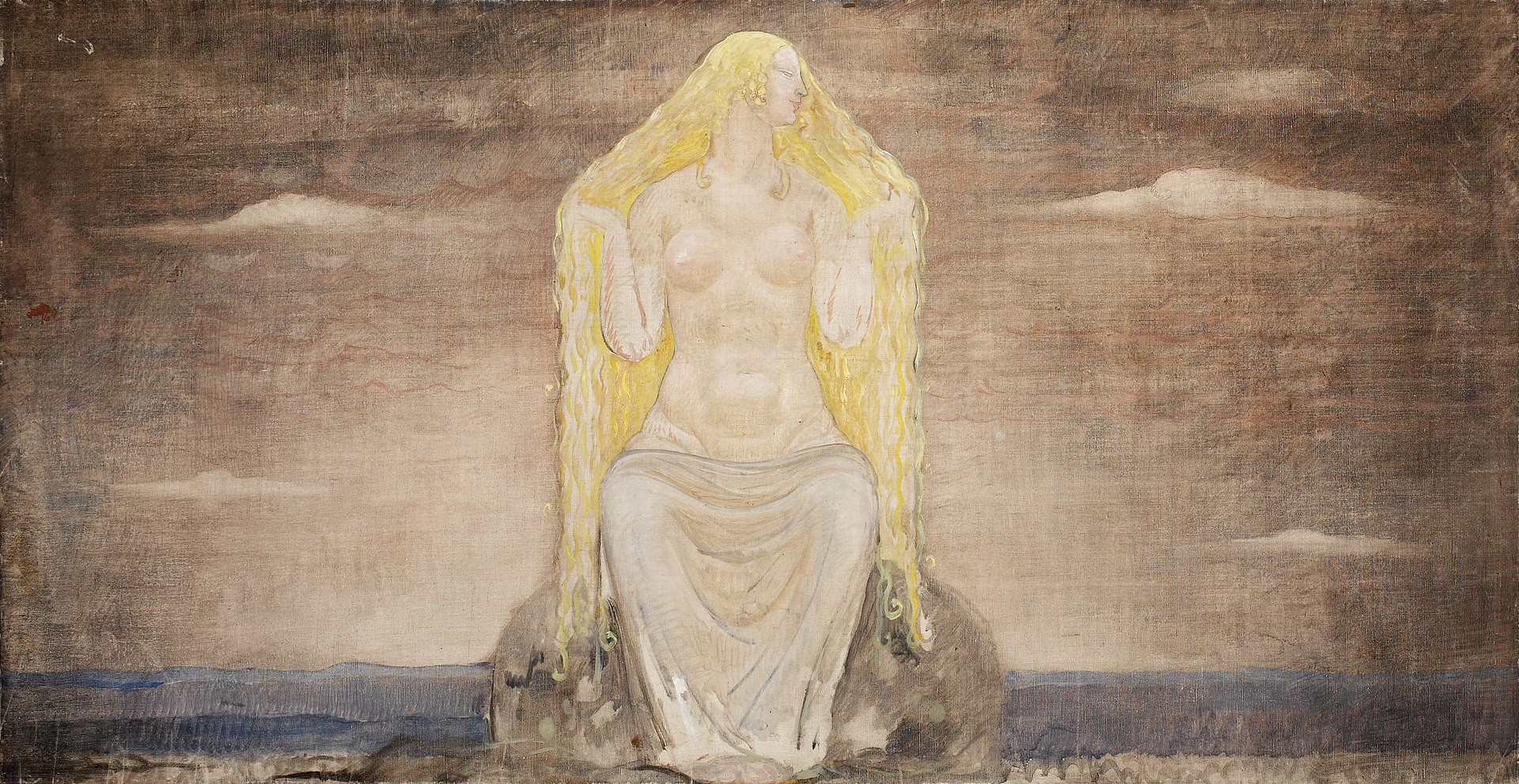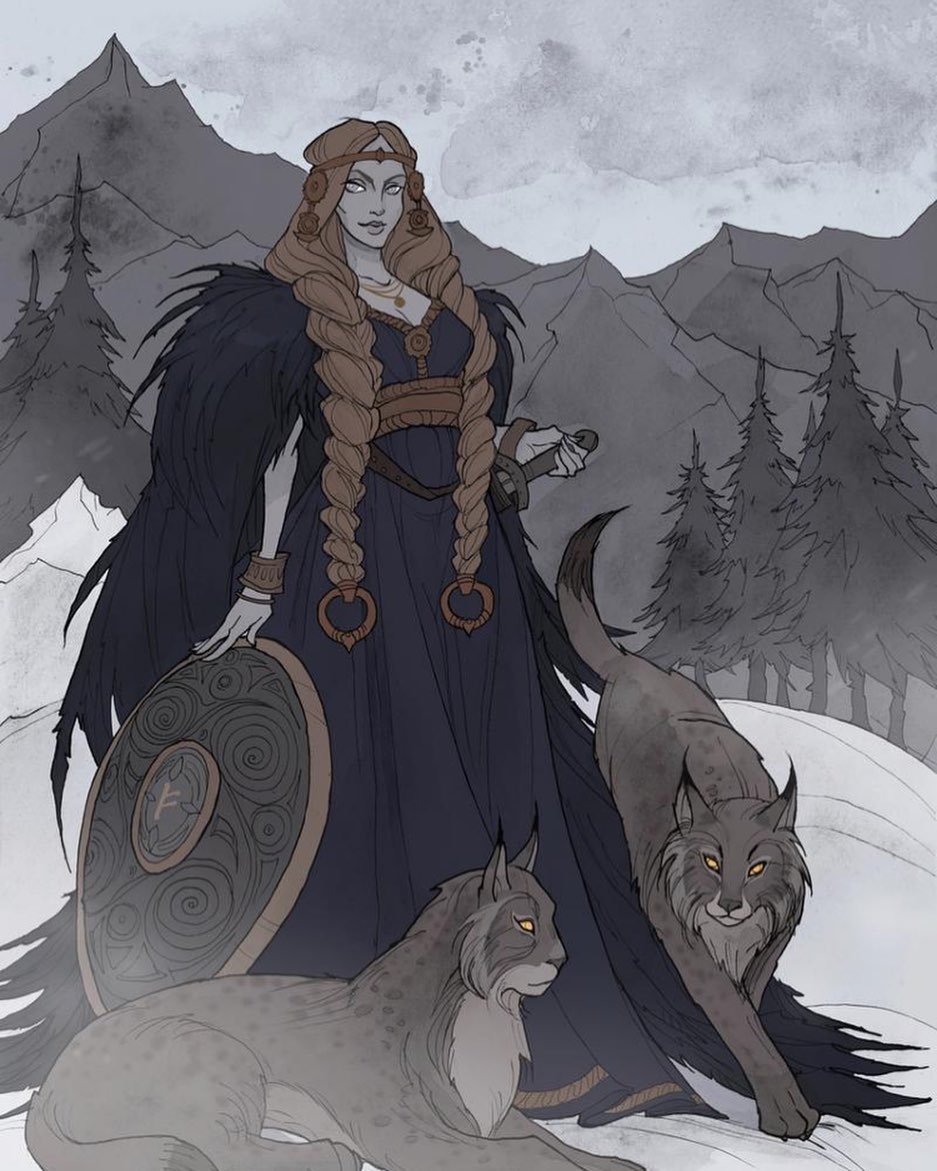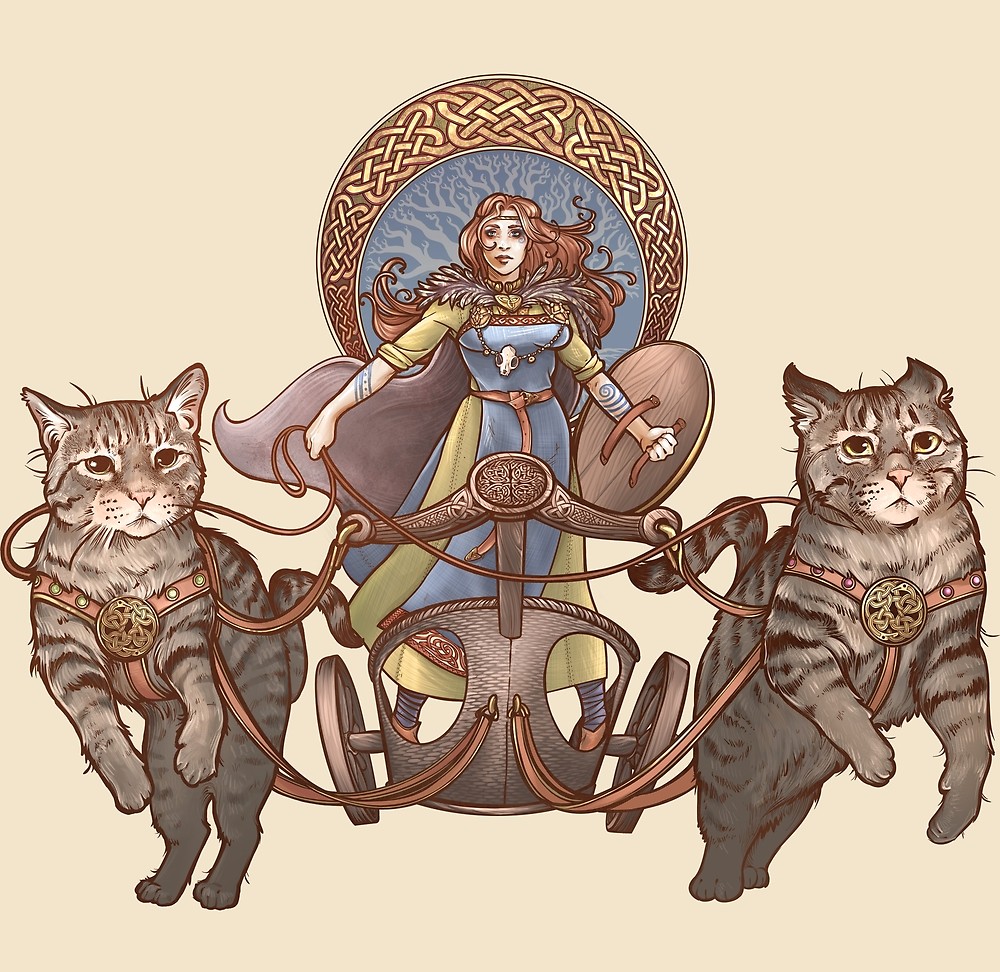Every year when there is a Friday the 13th, we’re actually celebrating Freyja’s Day. This is for two reasons. First, the English word Friday comes from the Scandinavian names for days of the week, and Friday is Frejya’s Day. Freyja’s number is 13, and therefore any Friday the 13th is her day, and a time to celebrate this goddess.
Who is Freyja? She’s a Norse goddess, and one of my favorite deities to work with, so I’d like to share the information I’ve compiled on her. Most of the information I’m sharing I’ve learned from Encyclopedia of Spirits: The Ultimate Guide to the Magic of Fairies, Genies, Demons, Ghosts, Gods & Goddesses by Judika Illes, in addition to supplemental sources on the internet.
There are other sources that go into greater depth, but keep in mind that like many other pagans around the world, the Norse people did not have a written language. Most common knowledge about pagan deities comes from the people who conquered them. For example, most of the information on Celtic tribes and their practices came from the Romans, who were pagan, but also had a written language.
Freja by John Bauer
What we know today about the Norse people and their customs comes from Christians who invaded and converted the people living in modern day Denmark, Sweden, Norway, and Iceland. Their traditions were captured in the Prose Edda and Poetic Edda by the Christian Snorri Sturluson, which were written in Icelandic. Women were not as highly regarded as men during the Viking era, so a greater emphasis has been placed on male deities, although the Norse pantheon certainly had a large amount of female deities as well.
Freyja, the Norse goddess of witchcraft, death, love, and fertility, was later condemned by Christian missionaries as the “Queen of Witches.”
About Freyja
Freyja is actually not technically a name—its literal translation means “Lady.” She has a brother, who goes by Freyr, whose name literally means “Lord.” Their parents are Njörðr, the Sea, and Herta, the Earth.
Freyja is the goddess of love, warfare, sex, fertility, death, beauty, magic, and witchcraft. She oversees battles, can bestow or remove fertility, can be petitioned for love, and was born knowing the divine secrets of witchcraft and the Runes. This is due to the fact that she is part of the Vanir, a people believed to practice witchcraft and have a strong connection to the Earth.
According to Judika Illes, “Freya was no obscure goddess but beloved and worshipped over a vast European territory including Scandinavia, Iceland, Greenland, the Germanic lands, Holland, and Anglo-Saxon Britain. She remains among the most beloved and widely venerated Pagan goddesses today. No spirit annoyed Christian authorities more than Freya. Ironically, the result was that Freya survives more vividly than virtually any other female European spirit. Constant condemnation kept Freya from fading into obscurity.”
Freyja in the Dwarf's Cave by Louis Huard
Illes continues: “Freya was denounced as a Queen of Witches. Women who venerated her were automatically branded ‘witches.’ And, of course, Freya’s rites and traditions did encourage magical practice, mediumship, shamanism, and female autonomy with Freya herself as the role model, behavior the new regime considered abhorrent and sinful.”
This does not come as much of a surprise: even though some pagan traditions relied heavily on heteronormative and patriarchal gender roles, there were outliers. Since Freyja oversaw battles and ruled over magic, she owned her own sense of power and ability to change fate. By being able to bestow and control magic, divination, fertility, love, war, and death, she held a great deal of power in her hands. It’s not a surprise someone considered so powerful, especially for females, was so difficult to extricate from the population Christian missionaries wanted to convert.
The Vanir
Norse gods are divided into two subgroups: the Æsir and the Vanir. Freyja and her family are part of the Vanir, and less is known about them than their counterparts. What is known is that the Æsir and Vanir were at war, and the Æsir were triumphant. As part of their truce agreement, Njörðr, Freyja, and Freyr were sent to live with the Æsir.
Norse mythology states the Vanir were living in what is now Scandinavia when the Æsir arrived. According to Judika Illes, “The Vanir evoked greater hostility from the Christian Church than their Aesir counterparts, so less information about the Vanir now survives.” The most we know about the Vanir is from those sent to live with Æsir.
What we do know about the Vanir is that they were shapeshifters associated associated with magic, creative energy, the sea, prophecy, eroticism, fertility, and shamanism. Our current view of elves is not so different from the Vanir, and it was believed that every rock, tree, and natural site had a Vanir spirit attached to it.
Personally, I find it interesting that the Vanir sound very powerful and mysterious, which is likely what made them seem like a threat to the Æsir. They held certain powers and knowledge unknown to the Æsir. The interesting part about this is that, according to the legend, Freyja shared much of her inherent knowledge with the Æsir shortly after becoming their hostage.
The Norse god Óðinn, a member of the Æsir, was the first to befriend her, and from her he learned the ways of seiðr, a form of magic and fortune telling that was considered women’s magic and not suitable for men. Freyja knew the meanings of the Runes, but according to the legend told by Snorri Sturluson, Freyja’s knowledge of the Runes led Óðinn to cut out one of his eyes and hang himself from Yggdrasil, the Tree of Life, for nine days while staring into the Well of Wyrd, the well the tree sits upon. After nine days and nine nights of staring into the well, the Runes appeared to him, and he knew their meaning.
Runes are the individual letters of the Norse alphabet, and were used for magical, divination, and fortune telling purposes. I find this particular story of Freyja and Óðinn fascinating because it shows the distinction between the Æsir and the Vanir. Óðinn had to put himself through a great tribulation to acquire knowledge Freyja already possessed.
However, considering that Óðinn was known for being very clever, this story is not a complete surprise because he likely saw an opportunity to learn something that most of his male peers would not, and he rebuffed criticism that associating with “women’s magic” made him weak. (The Norse placed a large emphasis on males doing strictly manly things and women doing strictly feminine things.) What I appreciate is that this was the beginning of Óðinn and Freyja working in tandem, both of them crossing expectations of their gender as they pleased.
Freya by irenhorrors
Warfare
When a battle takes place, Freyja takes on her nom de guerre Valfreya and leads the Valkyries to battle. The Valkyries are psychopomps who ferry souls of the recently dead to the next realm, and in battles would typically ferry them to two places. Valfreya has first pick of the dead, and Óðinn has second pick, but ultimately everyone who dies in battle is split evenly between the two.
Those whom Óðinn chooses go to live in with him in Valhalla. Those whom Freyja chooses are taken to her realm, which is known as Fólkvangr, a meadow with a large hall called Sessrúmnir, where love songs are constantly played.
Each of these powerful deities chooses soldiers who spend the afterlife with them and ultimately fight alongside them at Ragnarök, the end of the world and a massive battle. At Ragnarök the Jötnar (giants) who were present for the creation of Earth will leave their icy homes, Fenrir, a giant wolf held on a magical chain, will break loose and devour parts of the Earth, along with Óðinn. Until this point, both Freyja and Óðinn will fight alongside their chosen fallen soldiers. Freyja is among the spirits who survive Ragnarök, many of which are female.
Freya's Due by Sam Flegal
Freyja and Frigg
There are some interesting similarities between Freyja and the Norse goddess Frigg, who oversees and is Óðinn’s wife. Some believe it’s possible that these two are actually the same person or deity, and I think this is plausible, mainly due to the fact that Freyja is not a name, but a title, and Frigg is an actual name.
Frigg is known as a “Well Beloved Lady” and also goes by the names Frigga, Fricka, and Saga, and is the goddess of matrimony, fertility, divination, and childbirth. It is unknown if she is part of the Æsir or Vanir. As the wife of Óðinn she is associated with marriage and fidelity. Her bird is the Stork, and her hall is Fensalir, where happily married couples spend the afterlife together.
According to Judika Illes, “It can be very difficult to distinguish Frigg from Freya. Although clearly distinct spirits in Scandinavia, the two may have merged into one spirit in the German lands, although as so much information has been lost, suppressed, and garbled, it’s not impossible to definitively determine. Ironically, because Christian authorities despised Freya so intensely, more lucid, substantial information regarding her and her traditions survive.”
The theory that Freyja and Frigg are the same person is compounded by the belief that Óðr, Freyja’s husband, is actually Óðinn. Whether this is true or not, Óðr and Freyja had two daughters together: Hnoss and Gersemi. Not much is known about them.
Freya Driving Her Cat Chariot by Dani Kaulakis
Attributes & Associations
Freyja is known for being beautiful and having long blond hair, but she is also a shapeshifter and can take on any form. She has a magical falcon feather cloak that enables her to fly and wears a glowing necklace forged by dwarves called Brísingamen.
She rides a chariot pulled by two silver cats (possibly lynxes) that some say are named Bygul and Trjegul. Not surprisingly, Freyja is associated with cats, as well as falcons, rabbits, cuckoos, ladybugs, oxen, swallows, and boars. Her colors are yellow, white, green, red, pink, and light blue.
Freyja’s materials are gold and amber, and she loves flowers. The plants affiliated with her are Almond, Arnica, Bedstraw, Benzoin, Bird Berry, Clover, Cypress, English Daisy, Hemp, Henbane, Holly, Mistletoe, Mugwort, Opium Poppy, Primrose, Rose, and Strawberry. The essential oils associated with her are Benzoin, Birch, Cypress, Myrrh, Rose, and Sandalwood.
Offerings to Freyja can include any of these items, along with her favorite foods: Ale, Apples, Barley, Edible Flowers, Honey, Mead, and Pork. Treating cats well is one way to pay homage to her—either by feeding feral cats or adopting cats and treating them well. As the goddess of love, she enjoys love poems and songs, which can be heard at Fólkvangr.
Heimdallr returns the necklace Brísingamen to Freyja by Nils Blommér
Freyja’s Favorites
Since Freyja oversees love, sex, fertility, magic, witchcraft, warcraft, death, pleasure, glory, and beauty, her favored people are soldiers, veterans, jewelers, seers, shamans, witches, and practitioners of the magical arts. It is believed that you can use the Runes to communicate with her.
If you would like to work with Freyja, I suggest starting by introducing yourself and seeing if she wants to work with you. To do this, you can meditate, call her name in your mind three times, and see how she appears to you. If she does not look at you or does not appear, you are not meant to work with her at this time. If she does, you can see what she does or how she appears. Even if nothing much happens during your meditation, you may see her again in future meditations, or some clarity will come on the work you two are meant to do together.
Also, if you like Freyja’s energy and would like to find a way to incorporate that into your daily or self care routine, check out my recipe for a Freyja-themed Sugar Scrub with strawberries, almond, and honey.
RELATED BLOG POSTS
Lugh: Celtic God of Warfare, Poetry, Craftsmanship, and the Sun







